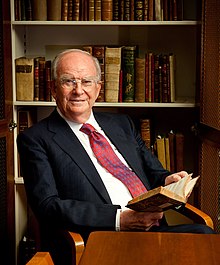
Back جون مويريج طوماس Arabic جون مويريج توماس ARZ جان موریق توماس AZB John Meurig Thomas Welsh John Meurig Thomas German John Meurig Thomas Spanish John Meurig Thomas Italian John Meurig Thomas Portuguese Томас, Джон Мейриг Russian John Meurig Thomas SIMPLE
Sir John Meurig Thomas | |
|---|---|
 Thomas in 2011 | |
| Born | 15 December 1932[3] Gwendraeth Valley, Carmarthenshire, Wales |
| Died | 13 November 2020 (aged 87) |
| Education | |
| Awards |
|
| Scientific career | |
| Institutions | |
| Thesis | The significance of structure in carbon-gas reactions (1957) |
| Doctoral advisor | Keble Sykes |
| Website | www |
| External videos | |
|---|---|
 | |
Sir John Meurig Thomas FLSW FRS HonFREng HonFRSE FRMS (15 December 1932 – 13 November 2020[4]), also known as JMT,[5] was a Welsh scientist, educator, university administrator, and historian of science primarily known for his work on heterogeneous catalysis, solid-state chemistry, and surface and materials science.[6][7]
He was one of the founders of solid-state chemistry, starting with his work at the University of Wales, Bangor, in 1958 when he investigated the various ways in which dislocations influence the chemical, electronic and excitonic properties of a range of solids. He was one of the first to exploit electron microscopy as a chemical tool, especially to deduce active-site reactivities from the surface topography of many minerals and crystal hydrates. At the University of Aberystwyth (1969–1978) he elucidated the surface chemistry of diamond, clay minerals, metals and intercalates by pioneering UV and X-ray photoelectron spectroscopy. He also initiated the field of crystal engineering of organic molecules. As head of physical chemistry department at the University of Cambridge (1978–1986), then a separate department to chemistry, he used magic-angle-spinning NMR and high-resolution electron microscopy to characterize and determine the structures of zeolites and other nanoporous catalysts. As Fullerian Professor and Director of the Royal Institution and of the Davy–Faraday Research Laboratory, he utilized synchrotron radiation to characterize, in situ, new catalysts designed for green chemistry and clean technology.[8][9]: 6–7, 623–638
He was the recipient of many national and international awards; and, for his contribution to geochemistry, the mineral meurigite was named in his honour.[10] He was Master of Peterhouse, University of Cambridge (1993–2002), and was knighted in 1991 "for services to chemistry and the popularisation of science".[11][12]
Thomas authored more than 1200 scientific articles and several books,[13][14] including Michael Faraday and the Royal Institution: The Genius of Man and Place (1991),[15] Principles and Practice of Heterogeneous Catalysis (with W. John Thomas, 1997, 2014),[16][17] and Design and Applications of Single-Site Heterogeneous Catalysts: Contributions to Green Chemistry, Clean Technology and Sustainability (2012).[18][19]
- ^ Cite error: The named reference
RMAWwas invoked but never defined (see the help page). - ^ Cite error: The named reference
Bakerianwas invoked but never defined (see the help page). - ^ "Thomas, Sir John Meurig". Who's Who. Vol. 2014 (online Oxford University Press ed.). A & C Black. (Subscription or UK public library membership required.)
- ^ "Y gwyddonydd, yr Athro Syr John Meurig Thomas, wedi marw" (in Welsh). BBC Cymru Fyw. 13 November 2020.
- ^ Cite error: The named reference
Joneswas invoked but never defined (see the help page). - ^ Somorjai, G. A.; Roberts, M. W. (2003). "A Tribute to John Meurig Thomas: Llongyfarchiadau ar eich penblwydd". Topics in Catalysis. 24 (1–4): 3–4. doi:10.1023/b:toca.0000003335.51469.58. S2CID 94423899.
- ^ "Sir John Meurig Thomas". BBC Radio Wales. 22 November 2011. Retrieved 16 November 2017.
- ^ Califano, Salvatore (2012). Pathways to modern chemical physics. Springer. p. 52. ISBN 978-3-642-28179-2. Retrieved 30 April 2019.
- ^ Cite error: The named reference
:0was invoked but never defined (see the help page). - ^ Birch, William D.; Pring, Allan; Self, Peter G.; Gibbs, Ronald B.; Keck, Erich; Jensen, Martin C.; Foord, Eugene E. (5 July 2018). "Meurigite, a new fibrous iron phosphate resembling kidwellite". Mineralogical Magazine. 60 (402): 787–793. doi:10.1180/minmag.1996.060.402.08. S2CID 58928381. Retrieved 29 April 2019.
- ^ "Symposium honours Professor Sir John Meurig Thomas". University of Cambridge. 13 December 2007. Retrieved 27 April 2018.
- ^ Cite error: The named reference
Wrightwas invoked but never defined (see the help page). - ^ Thomas, John Meurig (2017). Harris, Kenneth D. M. (ed.). The Selected Papers of Sir John Meurig Thomas. New Jersey: World Scientific. doi:10.1142/q0055. ISBN 978-1-78634-187-7.
- ^ John Meurig Thomas's publications indexed by the Scopus bibliographic database. (subscription required)
- ^ Thomas, J. M. (1991). Michael Faraday and the Royal Institution : the genius of man and place. New York; Milton Park, Abington: Taylor & Francis Group.
- ^ Thomas, John Meurig; Thomas, W. John (1997). Principles and practice of heterogeneous catalysis. Weinheim ; New York: VCH. ISBN 3-527-29288-8.
- ^ Thomas, John Meurig; Thomas, W. John (11 December 2014). Principles and practice of heterogeneous catalysis. John Wiley & Sons – VCH. ISBN 978-3-527-29239-4.
- ^ Cite error: The named reference
Wellswas invoked but never defined (see the help page). - ^ Cite error: The named reference
Catlowwas invoked but never defined (see the help page).
© MMXXIII Rich X Search. We shall prevail. All rights reserved. Rich X Search